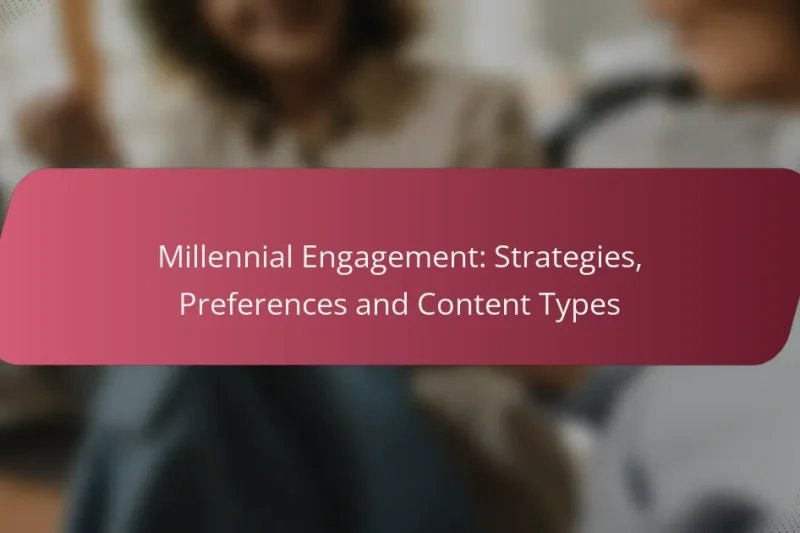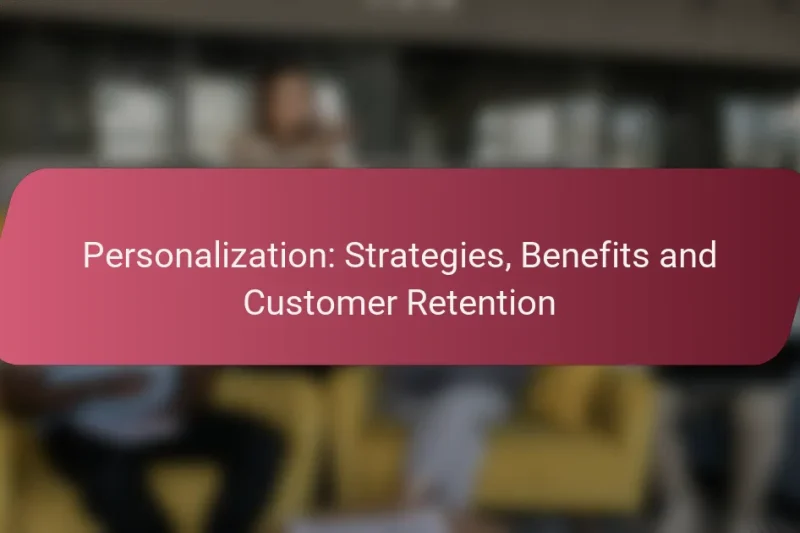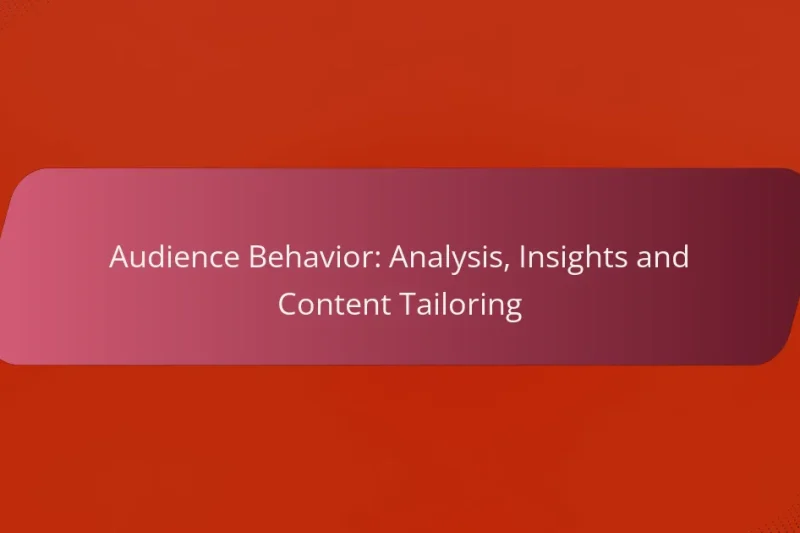Engaging millennials effectively requires a deep understanding of their values and preferences, focusing on personalized content … Millennial Engagement: Strategies, Preferences and Content TypesRead more
Audience Engagement Strategies
Effective audience engagement strategies are essential for creating meaningful connections with your audience, ultimately enhancing their interaction with your content. By leveraging digital platforms and fostering direct communication, businesses can increase loyalty, gather valuable feedback, and boost conversion rates.
Engagement Metrics: Comparison, Formats and Effectiveness
Engagement metrics are essential tools for evaluating user interactions with content, offering valuable insights into behavior … Engagement Metrics: Comparison, Formats and EffectivenessRead more
Interactive Content: Benefits, Formats and Engagement Techniques
Interactive content has become a powerful tool for businesses, offering benefits such as increased user engagement … Interactive Content: Benefits, Formats and Engagement TechniquesRead more
Personalization: Strategies, Benefits and Customer Retention
Personalization is a powerful strategy for enhancing customer retention by customizing experiences and communications to align … Personalization: Strategies, Benefits and Customer RetentionRead more
Audience Behavior: Analysis, Insights and Content Tailoring
Understanding audience behavior is crucial for creating engaging content that resonates with users. By analyzing data … Audience Behavior: Analysis, Insights and Content TailoringRead more
Social Media: Platforms, Strategies and Audience Reach
Social media has transformed the way businesses connect with their audiences, offering diverse platforms that cater … Social Media: Platforms, Strategies and Audience ReachRead more
Email Marketing: Techniques, Engagement and Content Promotion
Email marketing is a powerful tool that leverages personalization, segmentation, and automation to boost engagement and … Email Marketing: Techniques, Engagement and Content PromotionRead more
What are effective audience engagement strategies?
Effective audience engagement strategies are methods used to connect with your audience in meaningful ways, enhancing their experience and interaction with your content. These strategies can lead to increased loyalty, better feedback, and higher conversion rates.
Content personalization
Content personalization involves tailoring your messages and offerings to meet the specific preferences and behaviors of your audience. This can include using data to recommend products, customize emails, or create targeted content that resonates with individual users.
To implement personalization, consider using analytics tools to gather insights on user behavior. For example, e-commerce sites often show personalized product recommendations based on past purchases or browsing history, which can significantly boost engagement and sales.
Interactive content
Interactive content encourages active participation from your audience, making the experience more engaging. This can include quizzes, polls, surveys, and interactive infographics that invite users to interact rather than passively consume information.
For instance, a travel website might offer a quiz to help users find their ideal vacation destination. This not only keeps users engaged but also provides valuable data about their preferences, which can inform future marketing efforts.
Social media engagement
Social media engagement involves creating a dialogue with your audience through platforms like Facebook, Twitter, and Instagram. This strategy can enhance brand visibility and foster community by encouraging likes, shares, comments, and direct messages.
To maximize engagement, post regularly and respond promptly to comments and messages. Consider hosting live Q&A sessions or contests to stimulate interaction and build a loyal following.
Email marketing segmentation
Email marketing segmentation is the practice of dividing your email list into smaller groups based on specific criteria, such as demographics, purchase history, or engagement levels. This allows for more targeted and relevant messaging, improving open and click-through rates.
For example, a retail brand might send exclusive offers to frequent buyers while providing re-engagement campaigns for inactive subscribers. This tailored approach can significantly enhance the effectiveness of your email marketing efforts.
Live events and webinars
Live events and webinars provide opportunities for real-time interaction with your audience, allowing for deeper engagement through discussions, demonstrations, and Q&A sessions. These formats can help establish authority and build community among participants.
When planning a webinar, ensure it addresses specific topics of interest to your audience. Promote the event across your channels and consider offering incentives, such as exclusive content or discounts, to encourage attendance and participation.
How can businesses implement audience engagement strategies in the US?
Businesses in the US can implement audience engagement strategies by leveraging digital platforms and fostering direct communication with their customers. This involves using social media, email marketing, and interactive content to create meaningful connections and encourage feedback.
Utilizing local influencers
Partnering with local influencers can significantly enhance audience engagement by tapping into their established trust and rapport with the community. Businesses should identify influencers whose values align with their brand and who have a genuine connection with their audience.
To effectively collaborate, consider offering incentives such as free products, exclusive discounts, or commission-based partnerships. This approach not only amplifies reach but also fosters authenticity, as influencers can share personal experiences with your brand.
Creating community-driven content
Community-driven content encourages audience participation and strengthens connections. Businesses can create polls, surveys, or user-generated content campaigns that invite customers to share their stories or opinions, making them feel valued and heard.
For example, a restaurant could host a contest for the best customer recipe, featuring the winner on their menu. This not only engages the audience but also builds a sense of community around the brand, enhancing loyalty and repeat business.
What tools enhance audience engagement?
Several tools can significantly enhance audience engagement by facilitating communication, gathering feedback, and creating compelling content. Utilizing the right combination of these tools can lead to improved interaction and satisfaction among your audience.
HubSpot for CRM
HubSpot is a powerful Customer Relationship Management (CRM) tool that helps businesses manage interactions with current and potential customers. It centralizes customer data, allowing for personalized communication and targeted marketing efforts.
With features like email tracking, lead management, and analytics, HubSpot enables businesses to understand audience behavior and preferences. This insight can drive more effective engagement strategies, such as tailored content and timely follow-ups.
SurveyMonkey for feedback
SurveyMonkey is an effective platform for collecting audience feedback through surveys and polls. It allows businesses to gauge customer satisfaction, gather opinions on products, and understand audience needs.
Creating surveys is straightforward, with customizable templates and question types. Analyzing the results can reveal trends and insights, helping businesses make informed decisions to enhance engagement and address any concerns.
Canva for visual content
Canva is a user-friendly design tool that enables the creation of visually appealing content, which is crucial for capturing audience attention. It offers a wide range of templates for social media posts, presentations, and marketing materials.
Using Canva, businesses can produce high-quality graphics without needing extensive design skills. Engaging visuals can significantly improve audience retention and interaction, making it an essential tool for effective communication.
What metrics measure audience engagement?
Audience engagement can be measured through various metrics that provide insights into how effectively content resonates with viewers. Key metrics include click-through rates, social media interactions, and conversion rates, each offering unique perspectives on audience behavior and preferences.
Click-through rates
Click-through rates (CTR) indicate the percentage of users who click on a specific link compared to the total number of users who view a page, email, or advertisement. A higher CTR suggests that the content is compelling and relevant to the audience. Aim for a CTR of around 2-5% for email campaigns and 0.5-2% for display ads, depending on the industry.
To improve CTR, use clear calls to action (CTAs) and engaging headlines. Avoid misleading information, as this can lead to high bounce rates and damage credibility. Regularly test different formats and placements to find what works best for your audience.
Social media interactions
Social media interactions encompass likes, shares, comments, and overall engagement on platforms like Facebook, Twitter, and Instagram. These metrics reflect how well your content resonates with users and can help build community and brand loyalty. Aiming for consistent growth in interactions is crucial for maintaining audience interest.
To enhance social media interactions, create shareable content that encourages discussion. Use visuals and ask questions to prompt responses. Monitor engagement trends to identify what types of posts generate the most interaction, and adjust your strategy accordingly.
Conversion rates
Conversion rates measure the percentage of users who take a desired action, such as making a purchase or signing up for a newsletter, after engaging with your content. A strong conversion rate typically falls between 1-5%, depending on the industry and the specific action being measured. Tracking this metric helps assess the effectiveness of your marketing strategies.
To boost conversion rates, ensure your landing pages are optimized for user experience. This includes fast loading times, clear messaging, and easy navigation. Consider using A/B testing to refine your approach and identify the most effective elements that drive conversions.
What are the prerequisites for successful audience engagement?
Successful audience engagement requires a clear understanding of your audience’s needs and preferences, as well as effective communication strategies. Establishing a connection with your audience is crucial for fostering loyalty and encouraging interaction.
Understanding target demographics
Understanding target demographics involves identifying the specific characteristics of your audience, such as age, gender, location, and interests. This knowledge allows you to tailor your content and engagement strategies to resonate with your audience effectively.
To gather demographic information, consider using surveys, social media analytics, and website data. These tools can provide insights into who your audience is and what they care about, enabling you to create more relevant and engaging content.
When crafting your engagement strategies, focus on the preferences of your target demographics. For example, younger audiences may prefer interactive content like polls and quizzes, while older demographics might appreciate informative articles or videos. Adjust your approach based on the specific traits of your audience to maximize engagement.






